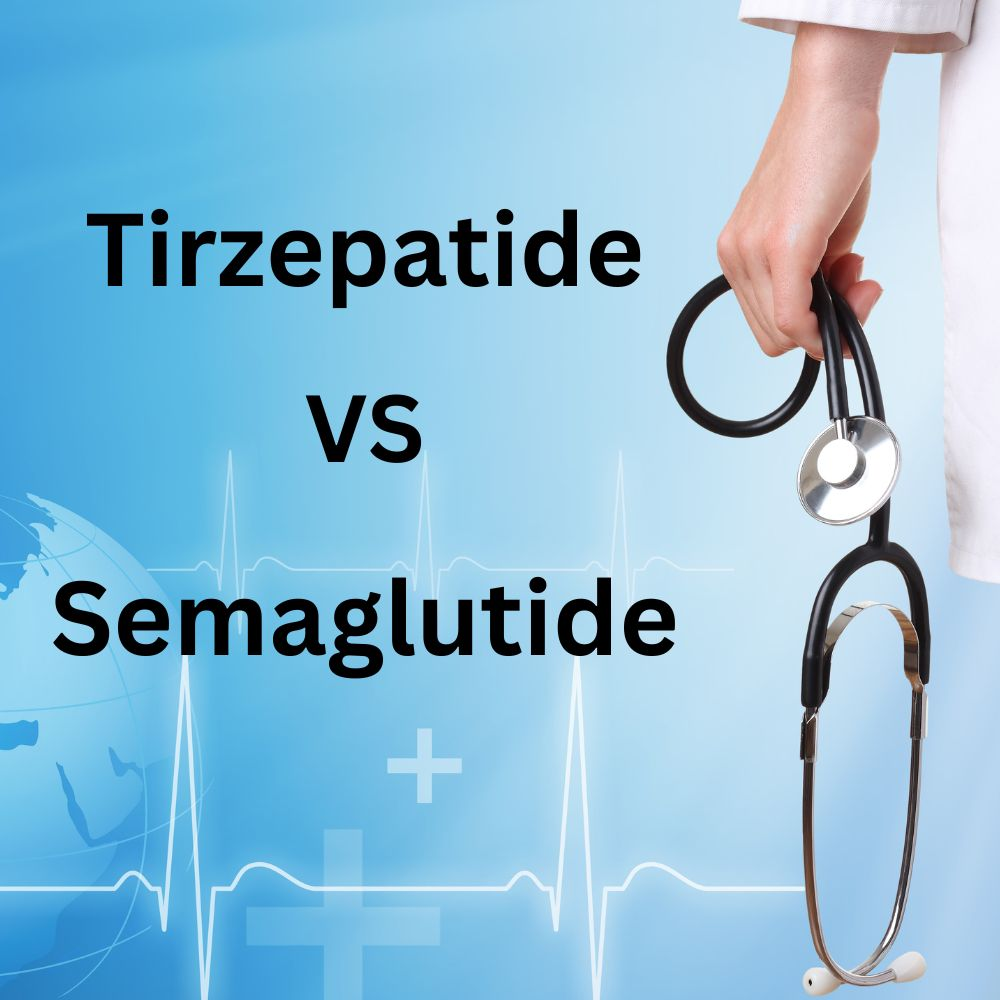Are you tired of the constant battle to lose weight, especially as a patient with type 2 diabetes? The struggle is real, but recent advances in weight loss medications offer new hope. In this blog post, we’ll dive deep into tirzepatide vs semaglutide, two promising medications that not only help with weight loss but also improve blood glucose control.
Key Takeaways
- Tirzepatide and semaglutide are medications designed to help type 2 diabetes patients achieve weight loss and lower their blood glucose levels.
- Clinical trials have demonstrated positive outcomes in glycemic control, with up to 20.9% mean percentage changes in weight, 85-91% experiencing a 5% or more reduction, and Manageable adverse event profiles.
- Real world experiences can provide additional insights into the efficacy of these treatments for informed decision making by healthcare providers & patients alike.
Understanding Tirzepatide and Semaglutide

Tirzepatide and semaglutide are medications specifically designed to help patients with type 2 diabetes achieve weight loss and lower their blood glucose levels. Tirzepatide is a dual glucose dependent insulinotropic agonist. It acts on both glucose-dependent insulinotropic polypeptide (GIP) and glucagon-like peptide-1 receptor (GLP-1 RA). On the other hand, semaglutide is a GLP-1 receptor agonist which works selectively. Both medications have demonstrated considerable decreases in body weight in clinical trials among patients with type 2 diabetes and obesity.
Both tirzepatide and semaglutide work by affecting the hormones that regulate food intake and blood glucose levels. Tirzepatide has been shown to reduce the rate of food passing through the body, leading to a feeling of satiety for a longer period of time and aiding in body weight reductions objectives. Semaglutide, on the other hand, has been shown to reduce appetite and slow gastric emptying, thus promoting a feeling of fullness and aiding in weight loss.
Although both medications have shown promise in clinical trials, the primary differences between them lie in their mechanisms of action and their efficacy in weight loss and blood glucose control. The subsequent sections delve into these differences, highlighting the results of clinical trials and expert viewpoints on their usage.
Tirzepatide: A Dual Receptor Agonist
Tirzepatide’s unique mechanism of action sets it apart from other weight loss medications. It targets both the GIP and GLP-1 receptors, leading to:
- Improved glycemic control
- Weight reduction
- Stimulating GLP-1 production in the body, aiding the body in producing more insulin when necessary
- GIP has been demonstrated to reduce food intake and boost energy expenditure, leading to reductions in body weight, glucose, and lipids.
The combined effects of GIP and GLP-1 receptor agonism in tirzepatide have resulted in:
- Improved glycemic control
- A feeling of satiety
- Body weight reduction
- Weight control
Its half-life of approximately 5 days makes tirzepatide a suitable option for patients on their weight loss journey.
Semaglutide: A GLP-1 Receptor Agonist

Semaglutide, meanwhile, targets only the GLP-1 receptor, resulting in blood sugar control and appetite suppression. It effectively replicates the GLP-1 receptor agonist, which is located in the area of the brain that influences satisfaction and hunger levels, thus aiding in the regulation of blood sugar levels and fat storage.
Apart from its role in blood sugar control, semaglutide has also demonstrated significant weight loss benefits. Research has shown that it can reduce cholesterol levels, triglycerides, and overall mortality rates in individuals with type 2 diabetes.
Semaglutide has been proven to facilitate a notable decrease in body weight, particularly when employed in conjunction with a healthy lifestyle to lose weight.
Clinical Trials: Comparing Efficacy and Safety

To better understand the efficacy and safety of tirzepatide and semaglutide, clinical trials have been conducted comparing the two medications in patients with type 2 diabetes. The trials were designed as a 40-week, open-label, parallel-group, randomized, active-controlled, phase 3 study. The primary endpoint was the change in glycated hemoglobin level from baseline to week 40, while the key secondary endpoints included:
- The change in body weight from baseline to week 40
- The attainment of glycated hemoglobin levels of less than 7.0%
- The attainment of glycated hemoglobin levels of less than 5.7%
These trials were conducted at 128 sites across the United States, Argentina, Australia, Brazil, Canada, Israel, Mexico, and the United Kingdom, including a total of 1879 participants with an average weight of 93.7 kg and an average age of 56.6 years. Both tirzepatide and semaglutide were administered in varying doses, with tirzepatide given in doses of 5 mg, 10 mg, or 15 mg, and semaglutide in a dose of 1 mg.
The subsequent sections provide a deeper look into the clinical trials’ results, highlighting outcomes related to glycemic control, weight loss, and safety.
Glycemic Control Outcomes
When it comes to glycemic control, both tirzepatide and semaglutide showed positive results in clinical trials. The results revealed that tirzepatide yielded a decrease of -2.01 percentage points at a 5 mg dose, -2.24 percentage points at a 10 mg dose, and -2.30 percentage points at a 15 mg dose. In comparison, semaglutide yielded a decrease of -1.86 percentage points. 82-86% of participants who took tirzepatide achieved the glycated hemoglobin level target of less than 7.0%. 79% of those who received semaglutide also achieved the same target.
The composite endpoint assessed in the clinical trials was:
- A glycated hemoglobin level of 6.5% or less, indicating a significant reduction
- Accompanied by a minimum 10% weight loss
- Without clinically significant hypoglycemia or severe hypoglycemia events
These results suggest that both tirzepatide and semaglutide can effectively improve glycemic control in patients with type 2 diabetes.
Weight Loss Outcomes
Weight loss outcomes were also favorable for both tirzepatide and semaglutide in clinical trials. The SURMOUNT-1 study focused on tirzepatide. At week 72, the following results were observed:
- A mean percentage change in weight of 15.0%, 19.5%, 20.9% was noted with 5mg, 10mg, and 15mg weekly doses of tirzepatide respectively, compared to 3.1% with a placebo.
- 85%, 89%, and 91% of participants receiving 5mg, 10mg, and 15mg of tirzepatide respectively experienced a weight reduction of 5% or more.
- 35% of the people receiving placebo also saw similar results.
These findings illustrate significant weight loss potential for both tirzepatide and semaglutide in patients with type 2 diabetes. It should be kept in mind though, that individual results can differ and factors such as medication adherence and lifestyle changes are pivotal in determining success.
Safety and Adverse Events
In terms of safety, both tirzepatide and semaglutide demonstrated manageable adverse event profiles in clinical trials. The most common adverse events reported were gastrointestinal in nature, primarily mild to moderate in severity. The percentages of patients experiencing these adverse events are as follows:
- Nausea: 17-22% in the tirzepatide group and 18% in the semaglutide group
- Diarrhea: 13-16% in the tirzepatide group and 12% in the semaglutide group
- Vomiting: 6-10% in the tirzepatide group and 8% in the semaglutide group
Other adverse events reported in the trials included immediate and non-immediate hypersensitivity events, diabetic retinopathy, and hypoglycemic events.
Awareness of these potential adverse events is key, yet the overall safety profiles of both tirzepatide and semaglutide imply their potential as safe and effective treatment options for patients with type 2 diabetes. Peptidevite may alleviate these side effects.
Additional Benefits and Considerations

Apart from their primary effects on weight loss and glycemic control, tirzepatide and semaglutide also offer additional benefits. Patients who received tirzepatide in clinical trials had an improved cardiovascular health. This includes improved lipid profiles, blood pressure, biomarkers of insulin sensitivity, and liver-enzyme levels. Semaglutide has also shown potential cardiovascular benefits, with research indicating that it can reduce cholesterol levels, triglycerides, and overall mortality rates in individuals with type 2 diabetes.
Factors such as real-world data studies, long-term weight loss, and correlation should also be considered when evaluating the use of tirzepatide and semaglutide for weight loss and glycemic control. For example, while clinical trials provide valuable information, real-world experiences and perspectives from patients, as well as expert opinions and recommendations, can offer additional insights into the effectiveness and safety of these medications.
Moreover, understanding the cost-effectiveness of tirzepatide and semaglutide factors significantly into the decision-making process for both patients and healthcare providers. The next section discusses the cost-effectiveness of these two medications.
Cost-Effectiveness Analysis

To evaluate the cost-effectiveness of tirzepatide and semaglutide for weight loss in patients with type 2 diabetes, a cost-effectiveness analysis was conducted. The study focused on the Cost to Treat (CNT) required to achieve a 1% decrease in body weight when administering semaglutide or tirzepatide. This measure was used as the primary outcome of the study. The drug costs were calculated based on US GoodRx prices as of October 2022, with the assumption that the price of the higher doses of both drugs would be comparable to the current price of the lower doses.
The cost-effectiveness analysis determined that per 1% of body weight reduction, tirzepatide is estimated to cost $985 compared with $1845 for semaglutide. This information can be valuable for patients and healthcare providers when weighing the benefits and costs of these medications for weight loss and glycemic control.
Accessing and Using Weight Loss Medications

Patients seeking to use tirzepatide and semaglutide for weight loss and blood glucose control should familiarize themselves with the process of obtaining and using these medications. Semaglutide is a popular weight loss medication, available in three different forms. These are injectable and branded as Wegovy and Ozempic, and oral under the name Rybelsus. In the UK, semaglutide is available under the same brand names. In order to utilise the full potential of Ozempic for successful weight loss and body weight reduction, certain criteria must be fulfilled. This includes meeting the body mass index requirements as set by Ozempic..
As outlined by the National Institute for Health and Care Excellence (NICE), semaglutide for weight loss can only be prescribed for a maximum duration of two years and must be administered as part of a specialized weight management service with multidisciplinary input. This ensures that patients receive comprehensive support and guidance throughout their weight loss journey.
Note that tirzepatide is currently under review for FDA approval. Nevertheless, given the promising results from clinical trials and expert viewpoints, tirzepatide could soon become another option for patients pursuing weight loss and glycemic control.
Real-World Experiences: Patient Perspectives

While clinical trials offer substantial information on the efficacy and safety of tirzepatide and semaglutide, real-world experiences and patient perspectives can provide additional insights. Patients using tirzepatide and semaglutide have generally reported positive experiences with regards to weight loss during treatment. Many have reported improvements in their weight and positive outcomes. However, it’s important to note that some may experience gastrointestinal adverse events such as nausea and diarrhea.
Given that individual experiences may vary and factors like medication adherence and lifestyle changes are crucial in determining success, it is essential for patients to collaborate with their healthcare providers to develop a personalized treatment plan considering their unique needs and circumstances.
Taking into account real-world experiences, clinical trial data, and expert opinions, patients and healthcare providers can make informed decisions about using tirzepatide and semaglutide for weight loss and glycemic control.
Expert Opinions and Recommendations
Experts are confident in the efficacy of both tirzepatide and semaglutide for weight loss and glycemic control. In head-to-head trials, tirzepatide showed a greater decrease in HbA1c levels, weight, and triglycerides, and has demonstrated superior and significant weight loss compared to a placebo. Semaglutide, on the other hand, also displayed a higher reduction in HbA1c levels, weight, and triglycerides.
Experts recommend that patients with type 2 diabetes consider tirzepatide and semaglutide to achieve weight loss and glycemic control. Both medications have been demonstrated to be effective and have been approved by the FDA.
Nonetheless, patients should consult with their healthcare providers to determine the best course of action tailored to their specific needs and circumstances.
Summary
In conclusion, tirzepatide and semaglutide offer promising solutions for patients with type 2 diabetes seeking weight loss and glycemic control. By understanding the mechanisms of action, clinical trial results, cost-effectiveness, and real-world experiences, patients and healthcare providers can make informed decisions about the best course of treatment. As the fight against obesity and diabetes continues, these medications provide a beacon of hope for those seeking a healthier future.
The information presented in this document is purely for educational purposes and should not be construed as medical advice. While every effort has been made to ensure the accuracy and reliability of the information provided, all health-related decisions should be made in consultation with a qualified healthcare professional. The author does not take any liability for the health decisions made by the reader.
Frequently Asked Questions
How is tirzepatide different from semaglutide?
Tirzepatide targets both the GLP-1 and GIP receptor agonist, while semaglutide only mimics the GLP-1 receptor. GLP-1R is a receptor protein found on beta cells of the pancreas and on neurons of the brain, which is involved in controlling blood sugar level by enhancing insulin secretion. Thus, the two drugs have different target sites and different mechanisms of action.
Which is better tirzepatide or Ozempic?
Tirzepatide appears to be more effective than Ozempic for weight loss and reducing cardiovascular disease risk, although it has a higher risk of hypoglycemia and thyroid tumors. However, the benefits of Tirzepatide may outweigh the risks for some patients. For example, those with a history of cardiovascular disease or obesity may find that the benefits of Tirzepatide outweigh the risks.
How do tirzepatide and semaglutide work to promote weight loss?
Tirzepatide and semaglutide work to promote weight loss by targeting GIP and GLP-1 receptors, respectively, resulting in improved glycemic control and appetite suppression. These drugs are effective in helping people lose weight and improve their glycemic control, but they come with potential side effects. Common side effects include nausea, vomiting, and diarrhea. It is important to discuss the potential risks and benefits of these medications with your doctor before starting them.
Are there any side effects associated with tirzepatide and semaglutide?
Gastrointestinal side effects such as nausea, diarrhea, and vomiting are the most commonly reported side effects associated with tirzepatide and semaglutide. Despite this, both medications have demonstrated to be safe and effective treatment options for type 2 diabetes.
How can patients access and use tirzepatide and semaglutide for weight loss and blood glucose control?
Patients can access and use semaglutide for weight loss and blood glucose control by obtaining Wegovy, Ozempic, or Rybelsus. Tirzepatide will soon be available for patients seeking weight loss and glycemic control.









